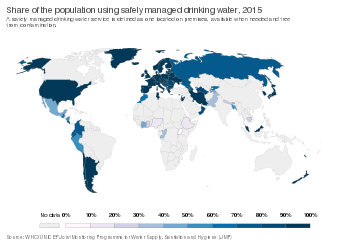Improved water source
An improved water source (or improved drinking-water source or improved water supply) is a term used to categorize certain types or levels of water supply for monitoring purposes. It is defined as a type of water source that, by nature of its construction or through active intervention, is likely to be protected from outside contamination, in particular from contamination with fecal matter.[1]

The term was coined by the Joint Monitoring Program (JMP) for Water Supply and Sanitation of UNICEF and WHO in 2002 to help monitor the progress towards Goal Number 7 of the Millennium Development Goals (MDGs). The opposite of "improved water source" has been termed "unimproved water source" in the JMP definitions. The same terms are used to monitor progress towards Sustainable Development Goal 6 (Target 6.1, Indicator 6.1.1) from 2015 onwards.
In 2017, JMP defined a new term: "basic water service". This is defined as the drinking water coming from an improved source, and provided the collection time is not more than 30 minutes for a round trip. A lower level of service is now called "limited water service" which is the same as basic service but the collection time is longer than 30 minutes.[2]
Definitions
To allow for international comparability of estimates for monitoring the Millennium Development Goals (MDGs), the World Health Organization/UNICEF Joint Monitoring Program (JMP) for Water Supply and Sanitation defines "improved" drinking water sources as follows:
- Piped water into dwelling[3]
- Piped water into yard/plot[3]
- Public tap/standpipes[3]
- Tubewell/boreholes[3]
- Protected dug wells[3]
- Protected springs (normally part of a spring supply)[3]
- Rainwater collection[3]
- Bottled water, if the secondary source used by the household for cooking and personal hygiene is improved[3]
Water sources that are not considered as "improved" are:
- Unprotected dug wells[3]
- Unprotected springs[3]
- Vendor provided water[3]
- Cart with small tank/drum[3]
- Bottled water, if the secondary source used by the household for cooking and personal hygiene is unimproved[3]
- Tanker-truck[3]
- Surface water[3]
See also
- Right to water
References
- WHO and UNICEF definitions of improved drinking-water source on the JMP website Archived 2012-06-06 at the Wayback Machine, WHO, Geneva and UNICEF, New York, accessed on June 10, 2012
- WHO and UNICEF (2017) Progress on Drinking Water, Sanitation and Hygiene: 2017 Update and SDG Baselines. Geneva: World Health Organization (WHO) and the United Nations Children’s Fund (UNICEF), 2017
- WHO and UNICEF types of improved drinking-water source on the JMP website Archived 2015-10-03 at the Wayback Machine, WHO, Geneva and UNICEF, New York, accessed on June 10, 2012